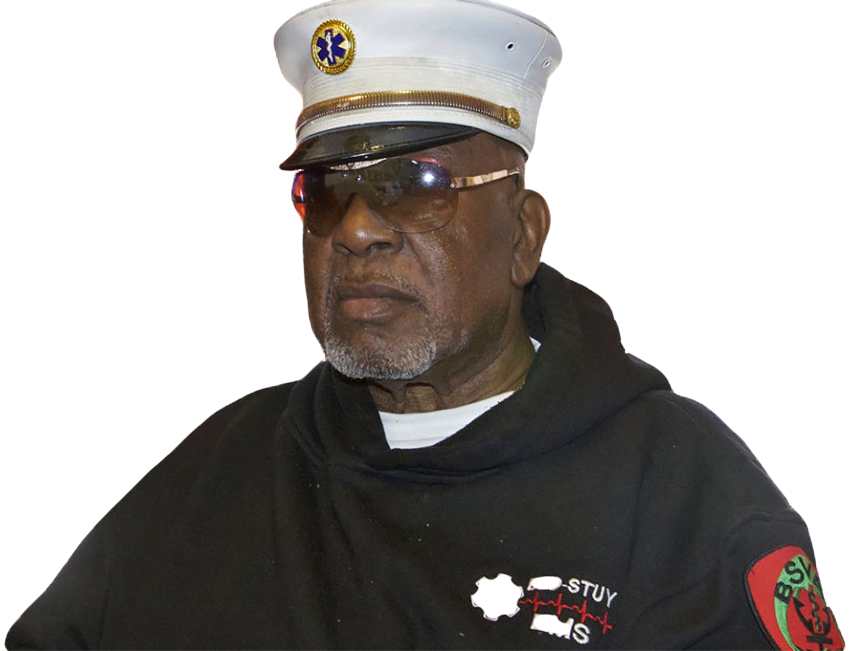Gun Stories
An EMS Worker in Bed-Stuy
James “Rocky” Robinson, 75, founder of the Bedford-Stuyvesant Volunteer Ambulance Corps, had an unusual path to becoming an EMS worker. He arrived home in the neighborhood one day to discover a car had hit his niece, who lived with him. When the paramedics arrived, they didn’t know how to revive her.
“She was in my arms. I’m crying, ‘Please don’t die, please don’t die,’” Robinson remembers. “And unfortunately she died, en route to the hospital. But that made me realize, man, that I’m not gonna let this happen to anybody else.”
So in 1988, Robinson and a friend opened the ambulance corps in Bed-Stuy—the nation’s first multi-cultural volunteer ambulance corps and EMT training center, according to Robinson. The Corps responds to about 400 emergency calls a month with an average response time of less than four minutes. It is connected to most hospitals in Brooklyn, with some 50 volunteers taking part. The majority of Robinson’s time is spent running his affiliated project, an EMS Academy, training the next generation of first responders. The Academy teaches CPR, first aid, and basic emergency medical training to neighborhood teens and young adults, many of who come from troubled homes.
In the eighties, when he founded the service, Bed-Stuy was known for violence related to crack cocaine. And Robinson says that throughout his career as an EMT, he has seen some terrible things, many of them related to guns.
Standard protocol calls for EMTs and paramedics to wait for the police to declare the scene of a crime secure before first responders are allowed to treat victims. However, such delay can mean a life is lost instead of saved. “I’ve had so many of those,” Robinson said. “ We go on the scene, a man is shot—we don’t wait for the police, which is crazy. We put the guy on the ambulance and start taking care of him.”
But moving in before the police can be dangerous: “I’ve had gotten calls where we got guys using the ambulance as protection as they’re continuing their war!” he said. Robinson remembers one gunshot call he received: when he arrived on the scene, people who seemed to be friends of the victim asked if the man would be alright. Robinson answered yes, but then, “One of the guys got on there and shot him again,” he said. Luckily the man lived, and later thanked Robinson for saving his life.
Although the precinct that includes Bed-Stuy still has one of the city’s highest rates of violent crime, murders have fallen—from 71 in 1990 to 11 in 2014, according to NYPD data. Robinson would like to help push such crimes down even further. The Bedford-Stuyvesant Volunteer Ambulance Corps has started a program called “Guns for Stethoscopes.” Every person who turns in a firearm gets CPR, first aid, and first-responder training for free. According to Robinson’s son, Antoine, the program, which only launched recently, hasn’t been terribly successful—only one person has participated thus far—but the group is hoping to grow with more marketing.
When Robinson speaks about the wild and violent calls he’s been on as an EMT, his voice goes soft. The experiences, he says, have made him fearful. “I still love people but I don’t trust anybody,” Robinson said. “I can’t tell you what I have to sleep, what I have to have beside me in order to feel safe, because it’s not legal.” He said he fears that somebody will break into his house.
But despite all the scary moments, Robinson calls himself a “life-saving junkie.” He sleeps with the police scanner on, as he’s able to pick some of the calls he goes on. There is one thing that his experiences have convinced him of: that guns have got to go.
“I don’t think we need guns,” he said. “I don’t even think police officers need guns. We have to fund another way. You got all these kids being shot to death because of a deranged mind? Are you kidding me? Why do they have to suffer for our indiscretions? It doesn’t matter the color—when are we gonna stop the violence? We gotta take away the guns, period.”
The Impact
One Shoe At A Time: A Mother Turns Pain Into Purpose
An Unsolved Shooting Baffles a Mom for Two Decades
How Grief and Anger Turned Into Action
Silver Gun: A Robbery in Queens
Shooter: “It’s Either Them or Me”
After a Single Dad is Shot, a Community Reels
